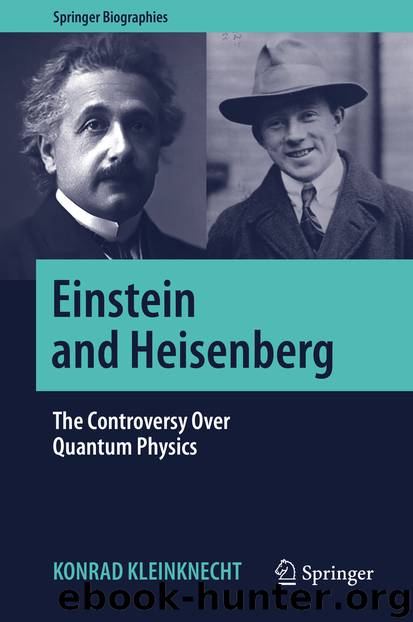Einstein and Heisenberg by Konrad Kleinknecht

Author:Konrad Kleinknecht
Language: eng
Format: epub
ISBN: 9783030052645
Publisher: Springer International Publishing
Dark Matter
The discovery of the cosmic background radiation by Penzias and Wilson in 1965 offered additional evidence of the Big Bang. This microwave radiation strikes Earth from every direction. The temperature of this radiation corresponds to 2.7 degrees above absolute zero, which is at minus 273 degrees Celsius. We believe this radiation to be from the cooled light particles from a distant primeval time, only about 380,000 years after the Big Bang. The radiation reveals to us how the formation of chunks of matter took place. Radiation at this temperature displays tiny fluctuations around one hundred thousandths of a degree. From this we can conclude how much matter of the kind we are familiar with was present at the time – it amounts to four percent of the total mass of the universe. The rest, whose nature we still do not know, appears to consist of non-luminous, “dark” matter, plus, as has emerged in recent years, mysterious dark energy.
The existence of dark matter emerges from the observation that the stars at the outer edges of spiral galaxies circle the galaxies’ centers at a higher velocity than would be calculated on the basis of Kepler’s laws of celestial mechanics. Therefore there must be more matter at the center of the galaxy than the totality of visible stars can account for. So far, it is unknown of what massive but non-luminous components this dark matter consists. But whatever it is, it constitutes one quarter of the mass of the universe.
The nature of dark energy is even more mysterious, its very existence uncertain. The hypothesis is based on the observation of supernovae of a certain type, Ia, whose absolute luminosity is the same in all cases, so that their distance can be determined from their apparent brightness. When the escape velocity of these supernovae is measured from the red shift, it is seen not only that the further these galaxies are away from us, the faster they are receding, as Hubble had found, but also that the escape speed of these galaxies accelerates. Such a phenomenon can be described with the field equations of general relativity theory by Einstein’s cosmological constant, if this is positive. The value of the constant, with which observations agree, is tiny: 10-17 grams per cubic meter. Why the constant has this value – Einstein had originally set it at zero – is entirely unknown.
Download
This site does not store any files on its server. We only index and link to content provided by other sites. Please contact the content providers to delete copyright contents if any and email us, we'll remove relevant links or contents immediately.
The Complete Stick Figure Physics Tutorials by Allen Sarah(6638)
Secrets of Antigravity Propulsion: Tesla, UFOs, and Classified Aerospace Technology by Ph.D. Paul A. Laviolette(3448)
Thing Explainer by Randall Munroe(3327)
The River of Consciousness by Oliver Sacks(2992)
The Order of Time by Carlo Rovelli(2714)
I Live in the Future & Here's How It Works by Nick Bilton(2524)
How To by Randall Munroe(2474)
A Brief History of Time by Stephen Hawking(2473)
The Great Unknown by Marcus du Sautoy(2186)
What If?: Serious Scientific Answers to Absurd Hypothetical Questions by Randall Munroe(2170)
Blockchain: Ultimate Step By Step Guide To Understanding Blockchain Technology, Bitcoin Creation, and the future of Money (Novice to Expert) by Keizer Söze(2137)
Midnight in Chernobyl by Adam Higginbotham(2078)
Networks: An Introduction by Newman Mark(1998)
The Meaning of it All by Richard Feynman(1909)
Easy Electronics by Charles Platt(1864)
The Tao of Physics by Fritjof Capra(1848)
When by Daniel H Pink(1777)
Midnight in Chernobyl: The Untold Story of the World's Greatest Nuclear Disaster by Adam Higginbotham(1775)
Introducing Relativity by Bruce Bassett(1754)
